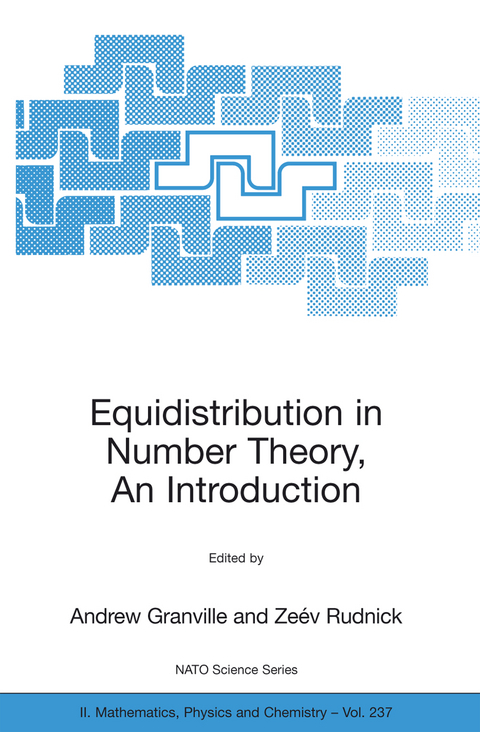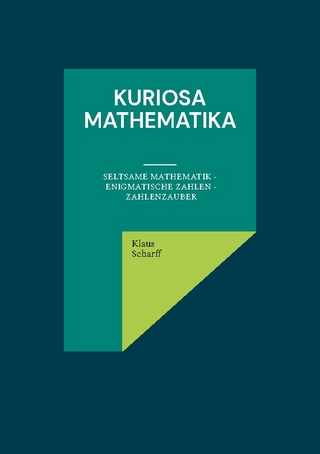
Equidistribution in Number Theory, An Introduction
Springer-Verlag New York Inc.
978-1-4020-5402-0 (ISBN)
Preface. Contributors.- Biographical Sketches of the Lecturers. Uniform Distribution.-
1. Uniform Distribution mod One.2. Fractional Parts of an2 .3. Uniform Distribution mod N.4. Normal Numbers. Sieving and the Erdos—Kac Theorem.- Uniform Distribution, Exponential Sums, and Cryptography .- 1 Randomness and Pseudorandomness. 2 Uniform Distribution and Exponential Sums. 3. Exponential Sums and Cryptography. 4. Some Exponential Sum Bounds. 5. General Modulus and Discrepancy of Diffie—Hellman Triples. 6. Pseudorandom Number Generation. 7 Large Periods and the Carmichael Function. 8 Exponential Sums to General Modulus. 9. Sums over Elliptic Curves. 10 Proof Sketch of Theorem 4.1. The Distribution of Prime Numbers.- 1. The Cramer Model and Gaps Between Consecutive Primes. 2 The Distribution of Primes in Longer Intervals. 3 Maier’s Method and an "Uncertainty Principle" .- Torsion Points on Curves.- 1. Introduction. 2. A Proof Using Galois Theory. 3. Polynomials Vanishing at Roots of Unity. The distribution of roots of a polynomial.- 1. Introduction. 2 Algebraic Numbers. 3 In k Dimensions: the Bilu Equidistribution Theorem. 4. Lower Bounds on Heights. 5. Compact Sets with Minimal Energy.- Manin—Mumford, André—Oort, the Equidistribution Point of View.- 1 Introduction.2 Informal Examples of Equi-Distribution.3. The Manin—Mumford and the André—Oort Conjecture. 4. Equidistribution of Special Subvarieties; Analytic Methods for the Distribution of Rational Points on Algebraic Varieties.- 1. Introduction to the Hardy—Littlewood Circle Method. 2. Major Arcs and Local Factors in the Hardy—Littlewood Circle Method. 3. The Minor Arcs in the Hardy—Littlewood Circle Method.4. Combining Analytic and Geometric Methods. Universal Torsors over Del Pezzo Surfaces and Rational Points.- 1. Introduction. 2. Geometric Background. 3. Manin’s Conjecture. 4. The Universal Torsor. 5. Summations.6. Completion of the Proof. 7. Equations of Universal Torsors.-An Introduction to the Linnik Problems.- 1. Introduction.2. The Linnik Problems. 3. Holomorphic Modular Forms of Half-Integral Weight. 4. Theta Series With Harmonic Polynomials. 5. Linnik Problem for Squares and the Shimura Lift. 6. Nontrivial Estimates for Fourier Coefficients.7. Salié Sums. 8. An Estimate of Iwaniec. 9. Theorems of Gauss and Siegel . 10. The Nonholomorphic Case (Duke, 1988). 11. Transition to Subconvexity Bounds for L-Functions. 12. An Application to Traces of Singular Moduli. Distribution Modulo One and Ratner’s Theorem.- 1. Introduction. 2. Randomness of Point Sequences mod 1. 3. ma mod One 4. vma mod One.5. Ratner’s Theorem. Spectral Theory of Automorphic Forms: A Very Brief Introduction.- 1. What Is a Homogeneous Space?. 2. Spectral Theory: Compact Case. 3. Dynamics. 4. Spectral Theory: Noncompact Case. 5. Hecke Operators. 6. Gross Omissions: The Selberg Trace Formula. Some Examples How to Use Measure Classification in Number Theory.- 1. Introduction. 2. Dynamical Systems: Some Background. 3. Equidistribution of n2a mod 1. 4. Unipotent Flows and Ratner’s Theorems. 5. Entropy of Dynamical Systems: Some More Background. 6. Diagonalizable Actions and the Set of Exceptions to Littlewood’s Conjecture. 7. Applications to Quantum Unique Ergodicity.-An Introduction to Quantum Equidistribution.- 1. Introduction. 2. A Crash Course in Classical Mechanics. 3.A Crash Course in Quantum Mechanics. 4. Two Words on Semi-Classical Analysis. 5. Quantum Mechanics on the Torus. The Arithmetic Theory of Quantum Maps.- 1. Quantum Mechanics on the Torus. 2. Quantizing Cat Maps. 3. Quantum Ergodicity. 4. Quantum Unique Ergodicity. 5. Arithmetic QUE
| Reihe/Serie | NATO Science Series II: Mathematics, Physics and Chemistry ; 237 |
|---|---|
| Zusatzinfo | XVI, 340 p. |
| Verlagsort | New York, NY |
| Sprache | englisch |
| Maße | 155 x 235 mm |
| Themenwelt | Mathematik / Informatik ► Mathematik ► Arithmetik / Zahlentheorie |
| Mathematik / Informatik ► Mathematik ► Wahrscheinlichkeit / Kombinatorik | |
| ISBN-10 | 1-4020-5402-5 / 1402054025 |
| ISBN-13 | 978-1-4020-5402-0 / 9781402054020 |
| Zustand | Neuware |
| Haben Sie eine Frage zum Produkt? |
aus dem Bereich


